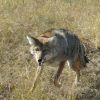Post by trappincoyotes39 on May 9, 2014 20:15:23 GMT -6
I saw on an other site a guy make a comment that WS trappers reported 3,500 beaver trapped in a year, he said "wonder what they did the other 11 months out of a year"?
I thought about that statement for a little while, what we do not know is , was this a new area they where working or one they have workd for a period of years reducing the beaver population from the factory areas? That makes a difference as well as fur trapping and ADC work takes on totally different mind sets and some guys have. Aged time grasping such. If people are hired to do ADC for a govt agency your doing the work on a requested basis in many cases and some them turn into an annual deal. far different than charging people by the head and it then is advantageous for one to find as many head to turn it for profit as possible.
The question then is : are you doing the person who is paying per head any good if taking critters too far away from their issue in the first place. A lot of this depends on species and hard to make such a blanket statement as he made without more details. if your in sheep country that has been worked for a period of years as most are and you then make the claim I went in and cleaned up catching 400 coyotes in 5 months how come there was 400 coyote to be had? or are you off on some cattlemen that are 6 miles away from this producer padding numbers? In many areas where sheep are produced coyote numbers are kept at lower than avg densities makes sense and is justified , yet again is it a wise use of the resources available paying for funding going 15 miles away to work on a cattlemen that has no history or perceived problems of depredation to show a higher head count?
beaver move up and into new areas annually by harvesting them in areas with less pressure you can slow,the migration of beaver into areas they are not wanted and reduce future work for a period of time. We would shotgun beaver in the spring to try and reduce the beaver factories so to slow migration up creeks and drainages and lessen the work load, doing this over time reduces the work load, as the factoirs are either in areas of little concern or very remote and not many really see the damage being done.
Coyotes different than beaver they will find refuge on many cattle operations as many of these guys have little issues and just won't call like sheepmen. So you will have a spring transition of coyotes to the sheep once lambing starts. They move from the cattlement to the sheep one gets out early enough you can end the issue before it becomes a problem most of the time. How far back do we do denning removal? depends on area and how many dens are in the area. The common line of thought is to kills back at least 2 miles and if a guy has the time 3 miles is better yet.
other areas harbor coyotes like Indian reservations and large tracts of US forest service grounds as well.
So doing this on an annual basis and with other factors we can go from having 3 active dens within striking distance to the sheep to one and over all lower coyote densities which sheep,ranchers like, but if we truly want to whack and stack them all we need to do is go out and work the cattlemen 4 miles and more away from a sheep producer and one can find a lot more coyotes generally speaking. There are many counties in the west with vastly reduced coyote numbers due to annual work done , work done in a manner that achieves the over all goal of reducing livestock depredation, this isn't head count work per say but selective removal and some guys who have been paid by the head have a hard time with seeing how that really does work, most guys getting paid by the head are not working for sheep producers but wildlife operators and a nuisance pair of coyotes here and there. So it behooves them to find as many to kill as possible in there situations as it makes them more money and the operators think large numbers mean a job well done! it will be an annual thing and it is darn hard to keep coyotes from filling in,the difference really is expectations and what is the goal.
sheepmen want to sell as many lambs as possible each Ocotber/Nov so den removal is paramount to lambs marketed. So your never going to have or shouldn't have a lot of coyotes around sheep producers , cattle producers far different and a guy can look like a king , working coyotes around cattlemen who have had little issues means far higher coyote densities and if one wants to impress with numbers then work the cattlemen . Sheepmen shouldn't expect to pay per head and they'd and shouldn't expect to pay for 150 head of coyotes or some questions need to be answered for sure. They want control and suppression of coyotes.
bottom line what do numbers really mean? it means you have high coyote densities and one can work hard or easier for those coyotes/beaver depending on situation and shear numbers of critters in a given area. The blanket statement first made I this post really tells us nothing about the situation at hand, nor should the guy who made the original post make such a claim without knowing the circumstances at hand.
I thought about that statement for a little while, what we do not know is , was this a new area they where working or one they have workd for a period of years reducing the beaver population from the factory areas? That makes a difference as well as fur trapping and ADC work takes on totally different mind sets and some guys have. Aged time grasping such. If people are hired to do ADC for a govt agency your doing the work on a requested basis in many cases and some them turn into an annual deal. far different than charging people by the head and it then is advantageous for one to find as many head to turn it for profit as possible.
The question then is : are you doing the person who is paying per head any good if taking critters too far away from their issue in the first place. A lot of this depends on species and hard to make such a blanket statement as he made without more details. if your in sheep country that has been worked for a period of years as most are and you then make the claim I went in and cleaned up catching 400 coyotes in 5 months how come there was 400 coyote to be had? or are you off on some cattlemen that are 6 miles away from this producer padding numbers? In many areas where sheep are produced coyote numbers are kept at lower than avg densities makes sense and is justified , yet again is it a wise use of the resources available paying for funding going 15 miles away to work on a cattlemen that has no history or perceived problems of depredation to show a higher head count?
beaver move up and into new areas annually by harvesting them in areas with less pressure you can slow,the migration of beaver into areas they are not wanted and reduce future work for a period of time. We would shotgun beaver in the spring to try and reduce the beaver factories so to slow migration up creeks and drainages and lessen the work load, doing this over time reduces the work load, as the factoirs are either in areas of little concern or very remote and not many really see the damage being done.
Coyotes different than beaver they will find refuge on many cattle operations as many of these guys have little issues and just won't call like sheepmen. So you will have a spring transition of coyotes to the sheep once lambing starts. They move from the cattlement to the sheep one gets out early enough you can end the issue before it becomes a problem most of the time. How far back do we do denning removal? depends on area and how many dens are in the area. The common line of thought is to kills back at least 2 miles and if a guy has the time 3 miles is better yet.
other areas harbor coyotes like Indian reservations and large tracts of US forest service grounds as well.
So doing this on an annual basis and with other factors we can go from having 3 active dens within striking distance to the sheep to one and over all lower coyote densities which sheep,ranchers like, but if we truly want to whack and stack them all we need to do is go out and work the cattlemen 4 miles and more away from a sheep producer and one can find a lot more coyotes generally speaking. There are many counties in the west with vastly reduced coyote numbers due to annual work done , work done in a manner that achieves the over all goal of reducing livestock depredation, this isn't head count work per say but selective removal and some guys who have been paid by the head have a hard time with seeing how that really does work, most guys getting paid by the head are not working for sheep producers but wildlife operators and a nuisance pair of coyotes here and there. So it behooves them to find as many to kill as possible in there situations as it makes them more money and the operators think large numbers mean a job well done! it will be an annual thing and it is darn hard to keep coyotes from filling in,the difference really is expectations and what is the goal.
sheepmen want to sell as many lambs as possible each Ocotber/Nov so den removal is paramount to lambs marketed. So your never going to have or shouldn't have a lot of coyotes around sheep producers , cattle producers far different and a guy can look like a king , working coyotes around cattlemen who have had little issues means far higher coyote densities and if one wants to impress with numbers then work the cattlemen . Sheepmen shouldn't expect to pay per head and they'd and shouldn't expect to pay for 150 head of coyotes or some questions need to be answered for sure. They want control and suppression of coyotes.
bottom line what do numbers really mean? it means you have high coyote densities and one can work hard or easier for those coyotes/beaver depending on situation and shear numbers of critters in a given area. The blanket statement first made I this post really tells us nothing about the situation at hand, nor should the guy who made the original post make such a claim without knowing the circumstances at hand.



